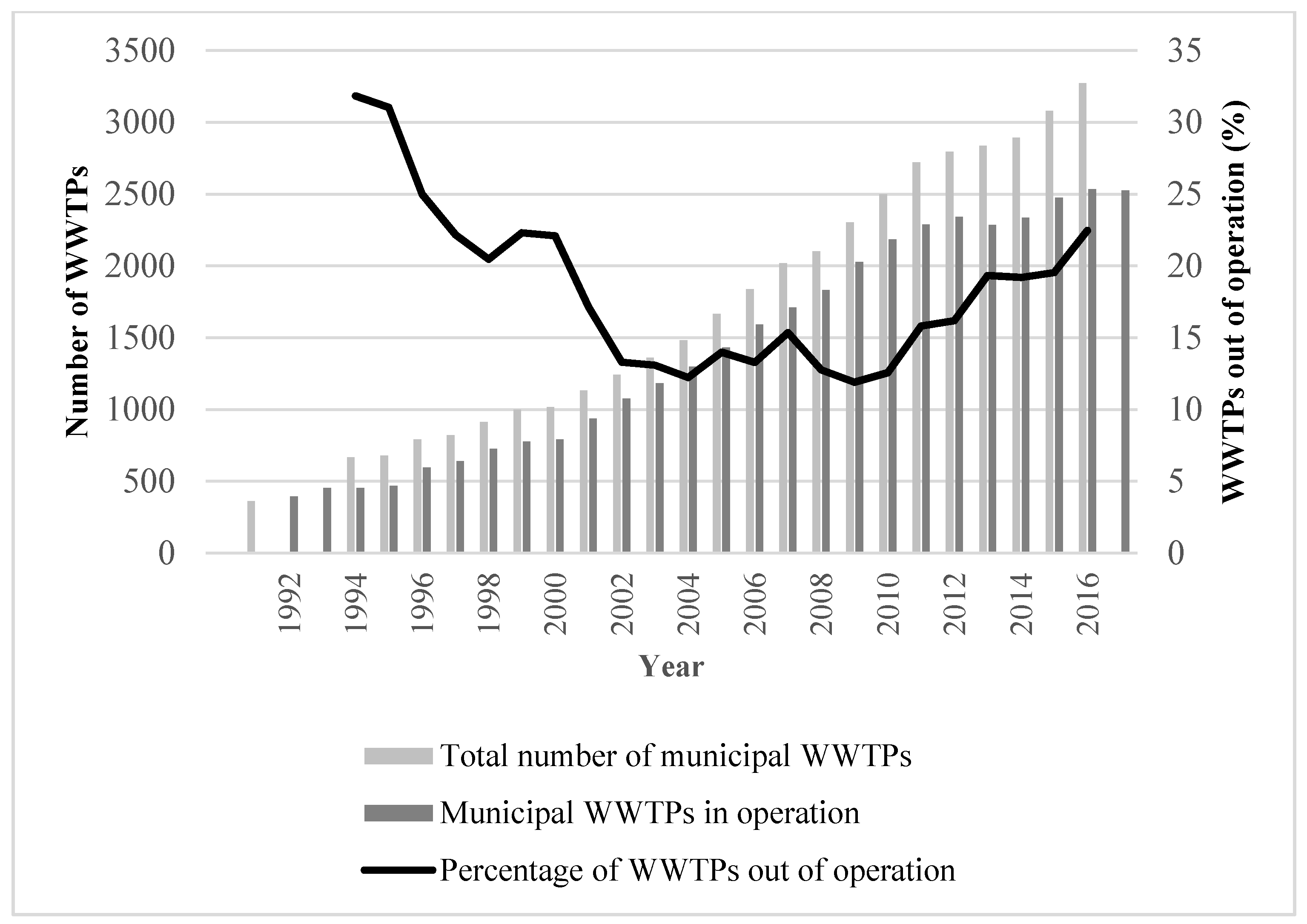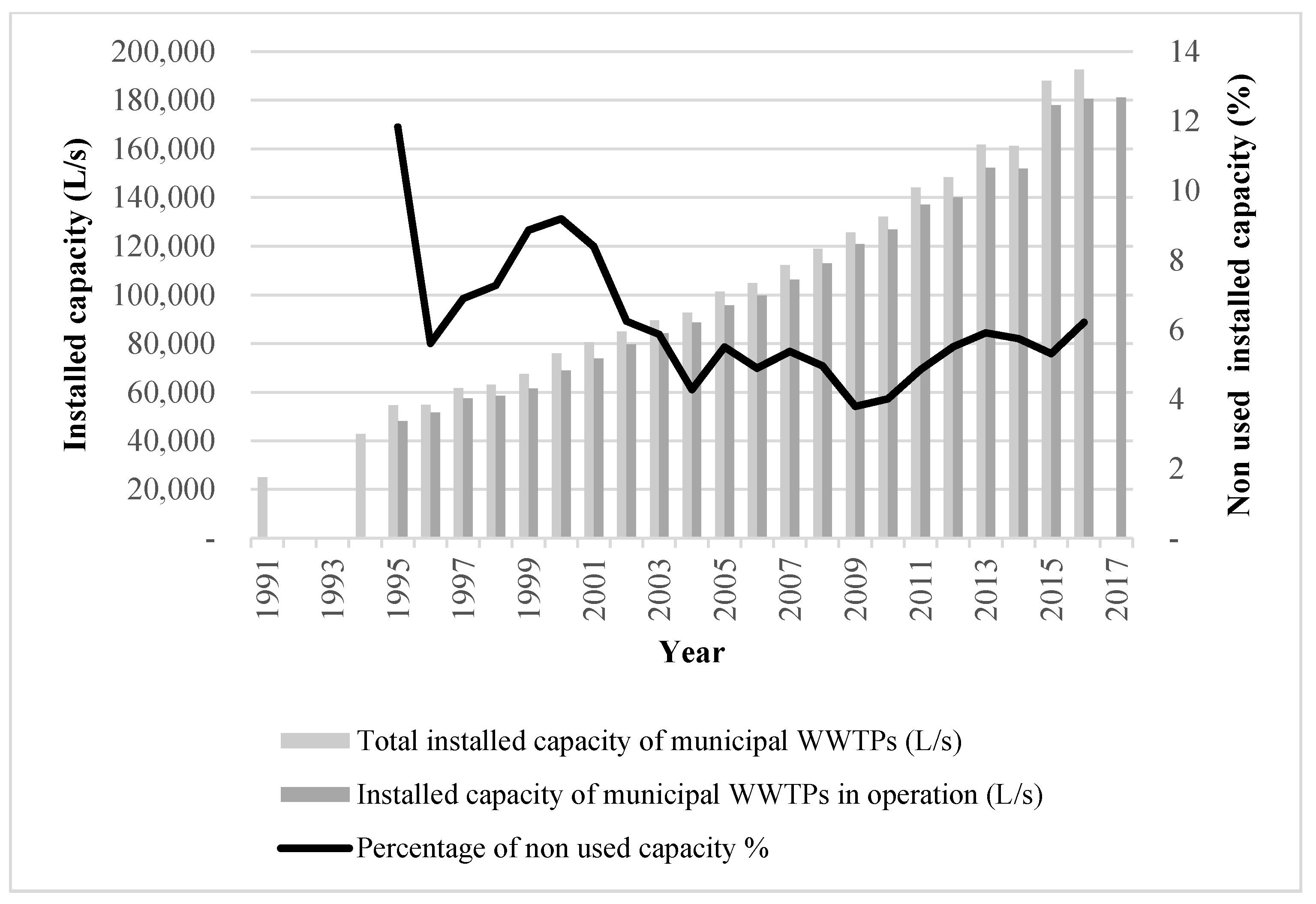Sustainable Wastewater Management to Reduce Freshwater Contamination and Water Depletion in Mexico
Abstract
:1. Introduction
2. Materials and Methods
3. Results
3.1. Consumptive Water Use
3.2. Sewage and Treatment Coverage
3.3. Reuse of Treated Wastewaters
4. Discussion
4.1. Internal Process Perspective
- The urban concentration in Mexico today exerts a high to very high level of water stress and water scarcity in most cities located in Central and Northern Mexico [30].
- There is still an important gap between the sewage generated by the population and the percentage of sewer coverage to collect this sewage [5].
- Due to the lack of infrastructure for the management of urban rainwater, wastewater and rainwater are mixed in the same municipal sewage systems, meaning that opportunities for the aquifers to be recharged and for rainwater storage and reuse are lost [5].
- Most municipal WWTPs are bypassed during the rainy season because they were not designed to handle the volumes associated with heavy rainfalls. As a result, during the rainy season, many of the receiving water bodies are contaminated by excess organic loads and other pollutants (personal communication with State Water Commission in Jalisco).
- The leaks in the sewerage network are as high as 40% in urban areas [31].
- More than 70% of the municipal wastewater treatment technologies installed in the country require intensive energy use and high Maintenance and Operational (M&O) costs, such as activated sludge, aerated lagoons, and dual anaerobic–aerobic systems [5].
4.2. Users’ Perspectives
- The interruption of drinking water services in cities during the dry season is more and more frequent.
- There is increasing social discontent due to the high level of contamination of surface waters in Mexico and the resultant consequences for public health.
- Farmers refuse to reduce their rights to water extraction volumes from their wells, because they could lose their government-approved water concessions if they agree to use treated water from the municipality.
- Municipal politicians fear the loss of voter support if water metering is installed. At present, a single fee per user is applied, which is generally insufficient to pay for potable water treatment and for sewage treatment services. The consequence of accepting such a measure is the overuse and overexploitation of the local water resources and the contamination of surface- and groundwaters due to lack of, or inefficient, treatment infrastructures.
- Water managers of municipalities with conventional WWTPs consider that the government incentives to cover part of their Maintenance and Operating (M&O) costs are insufficient to keep the facilities in good operating condition and that, in any case, the process of getting such incentives is highly bureaucratic.
4.3. Financial Perspective
- The ground- and surface water volumes given in concession by CONAGUA for agriculture in Mexico cost nothing for farmers if they do not exceed the volume granted by CONAGUA, so, in most cases, farmers prefer to use well water than to use treated water from the municipality [32].
- In some municipalities, the aquifers are overexploited, but the extraction of the water given in concession by CONAGUA to the farmers is still preferred, because, as noted above, there is no cost for the water, and the energy costs of pumping for agriculture are subsidized by the Federal Electricity Commission.
- The centralization of the municipal wastewater treatment service involves the commitment to invest, build, and operate a complex facility requiring regular high expenditures for M&O.
- Medium-sized or large treatment infrastructure projects usually require development banking funds. With this, the municipality acquires long-term debts that, usually, it cannot pay.
- In most cases, the wastewater treatment plants do not have a wastewater reuse plan.
- Most municipalities do not have a decentralized water operating agency with financial independence from the municipality. As a result, the expected annual municipal budget for treatment is generally insufficient to maintain the WWTP M&O costs.
- Municipalities with a low population normally do not have water consumption meters and pay an annual fee for water services for housing independent of water consumption. This practice has led to the overuse of water, overexploitation of aquifers, and insufficient income to provide adequate potable water and treatment services to users.
- A lack of long-term political continuity in the municipalities to get financial resources with the state and federal agencies that manage the water resources affects the plans to expand the treatment coverage and the renewal of existing treatment infrastructures.
- Frequently, the managers of potable water and treatment services do not have enough information about the subsidies from CONAGUA to finance part of the M&O expenditures of the WWTP [33].
- Many municipalities do not have a treatment service for their wastewater and prefer to pay fines for unregulated discharges, because they do not want to incur financial debts or permanent M&O expenses.
- Knowing the financial limitations of the municipalities, CONAGUA usually defers the fines to municipalities that do not comply with the Mexican Federal Law of Rights declared in its article 276 [34].
4.4. Learning and Growth Perspectives
- Frequently, water managers do not have a basic educational background in subjects such as hydrology, laws, and the regulations related to the management of water resources or the basic principles of hydraulic urban infrastructure.
- Sporadic communication between municipal, state, and federal agencies results in the failure of water and wastewater management plans.
- In most cases, there is an absence of a vision of IWRM based on the hydrologic resources of the basins and subbasins and a lack of expertise and research programs to accelerate technology development and technology transfer activities that can offer innovative treatment technologies with low energy consumption and a low carbon footprint.
- Poor community participation in decision-making in the management of water resources results in limited confidence in the decisions of municipal representatives.
- A lack of transparency of the municipal authorities in the management of financial resources generates distrust in the community, and participation in community initiatives declines.

4.5. The Sustainable Approach
4.5.1. Social Dimension
4.5.2. Environmental and Technological Dimension
4.5.3. Economic and Legal Dimension
4.5.4. Political Dimension
5. Conclusions
Author Contributions
Funding
Acknowledgments
Conflicts of Interest
References
- UNEP. The Pollution of Lakes and Reservoirs; UNEP Environmental Library No. 12; United Nations Environment Programme: Nairobi, Kenya, 1994; p. 35. Available online: https://wedocs.unep.org/handle/20.500.11822/32410 (accessed on 4 July 2021).
- Peters, N.E.; Meybeck, M. Water Quality Degradation Effects on Freshwater Availability: Impacts of Human Activities. Water Int. 2000, 25, 185–193. [Google Scholar] [CrossRef]
- Edokpayi, J.N.; Odiyo, J.O.; Durowoju, O.S. Impact of Wastewater on Surface Water Quality in Developing Countries: A Case Study of South Africa. IntechOpen 2016, 18, 401–416. [Google Scholar] [CrossRef] [Green Version]
- CONAGUA. Estadísticas del Agua en México; Comisión Nacional del Agua. Secretaría de Medio Ambiente y Recursos Naturales: Mexico City, México, 2018; p. 306. Available online: http://sina.conagua.gob.mx/publicaciones/EAM_2018.pdf (accessed on 4 July 2021).
- De Anda-Sánchez, J. Saneamiento descentralizado y reutilización sustentable de las aguas residuales municipales en México. Soc. Ambiente 2017, 5, 119–143. [Google Scholar] [CrossRef]
- Cotler-Ávalos, H. Las Cuencas Hidrográficas de México. Diagnóstico y Priorización; Secretaría de Medio Ambiente y Recursos Naturales, Instituto Nacional de Ecología: Mexico City, Mexico, 2010; p. 231. ISBN 978-607-7655-07-7.
- Spring, Ú.O. Water security and national water law in Mexico. Earth Perspect. 2014, 1, 7. [Google Scholar] [CrossRef] [Green Version]
- Arreguin-Cortes, F.I.; Saavedra-Horita, J.R.; Rodriguez-Varela, J.M.; Tzatchkov, V.G.; Cortez-Mejia, P.E.; Llaguno-Guilberto, O.J.; Sainos-Candelario, A. State level water security indices in Mexico. Sustain. Earth 2020, 3, 1–14. [Google Scholar] [CrossRef]
- Anda-Sánchez, J. Precipitation in Mexico. In Water Resources of Mexico; Raynal-Villaseñor, J.A., Ed.; World Water Resources; Springer: Cham, Switzerland, 2020; Volume 6, pp. 1–14. [Google Scholar]
- Aqueduct Tools. Aqueduct Water Risk Atlas. Available online: https://www.wri.org/aqueduct (accessed on 3 June 2021).
- United Nations. Department of Economic and Social Affairs. Sustainable Development. Sustainable Development Goal 6: Ensure Availability and Sustainable Management of Water and Treatment for All. Available online: https://sustainabledevelopment.un.org/sdg6 (accessed on 3 June 2021).
- Indicadores Demográficos de la República Mexicana. Consejo Nacional de Población. México D. F., México. Available online: http://www.conapo.gob.mx/work/models/CONAPO/Mapa_Ind_Dem18/index_2.html (accessed on 3 June 2021).
- El Medio Ambiente en México 2013–2014. Agua, Calidad. Secretaría de Medio Ambiente y Recursos Naturales. Available online: https://apps1.semarnat.gob.mx:8443/dgeia/informe_resumen14/06_agua/6_2_3.html (accessed on 3 June 2021).
- De Anda, J.; Shear, H. Challenges facing municipal wastewater treatment in Mexico. Public Work. Manag. Policy 2008, 12, 590–598. [Google Scholar] [CrossRef]
- De Anda, J.; Shear, H. Searching for a sustainable model to manage and treat wastewater in Jalisco, Mexico. Int. J. Dev. Sustain. 2016, 5, 278–294. Available online: https://isdsnet.com/ijds-v5n6-3.pdf (accessed on 14 August 2021).
- De la Peña, M.E.; Ducci, J.; Viridiana, Z. Tratamiento de Aguas Residuales en México, Nota Técnica # IDB-TN-521; Banco Interamericano de Desarrollo: Washington, DC, USA, 2013; p. 42. Available online: https://webimages.iadb.org/publications/spanish/document/Tratamiento-de-aguas-residuales-en-M%C3%A9xico.pdf (accessed on 3 June 2021).
- Kaplan, R.S.; Norton, D.P. Using the balanced scorecard as a strategic management system. Harv. Bus. Rev. 1996, 74, 75–85. [Google Scholar]
- Epstein, M.J.; Wisner, P.S. Using a Balanced Scorecard to Implement Sustainability. Environ. Qual. Manag. 2001, 11, 1–10. [Google Scholar] [CrossRef]
- Guimarães, B.; Simões, P.; Marques, R.C. Does performance evaluation help public managers? A Balanced Scorecard approach in urban waste services. J. Environ. Manag. 2010, 91, 2632–2638. [Google Scholar] [CrossRef] [PubMed]
- Abdelghany, M.; Abdel-Monem, M. Balanced scorecard model for water utilities in Egypt. Water Pract. Technol. 2019, 14, 203–216. [Google Scholar] [CrossRef]
- Harris, J.M. Basic Principles of Sustainable Development. Global Development and Environment Institute, Working Paper 00-04; Tufts University: Medford, MA, USA, 2000; p. 26. Available online: https://sites.tufts.edu/gdae/files/2019/10/00-04Harris-BasicPrinciplesSD.pdf (accessed on 3 June 2021).
- Holden, E.; Linnerud, K.; Banister, D. Sustainable development: Our Common Future revisited. Glob. Environ. Chang. 2014, 26, 130–139. [Google Scholar] [CrossRef] [Green Version]
- Pawłowski, A. How Many Dimensions Does Sustainable Development Have? Sustain. Dev. 2008, 16, 81–90. [Google Scholar] [CrossRef]
- McConville, J.R.; Mihelcic, J.R. Adapting Life-Cycle Thinking Tools to Evaluate Project Sustainability in International Water and Treatment Development Work. Environ. Eng. Sci. 2007, 24, 937–948. [Google Scholar] [CrossRef]
- Saad, D.; Byrne, D.; Drechsel, P. Social perspectives on the effective management of wastewater. IntechOpen 2017, 12, 253–267. [Google Scholar] [CrossRef] [Green Version]
- Progress on Integrated Water Resources Management. Global Baseline for SDG 6 Indicator 6.5.1: Degree of IWRM Implementation. Available online: https://www.unwater.org/publications/progress-on-integrated-water-resources-management-651/ (accessed on 3 June 2021).
- Urban Population (% of Total Population)—Mexico. World Bank. Available online: https://data.worldbank.org/indicator/SP.URB.TOTL.IN.ZS?locations=MX (accessed on 3 June 2021).
- Normas Oficiales Mexicanas. Secretaría de Medio Ambiente y Recursos Naturales. Comisión Nacional de Agua. Available online: http://www.conagua.gob.mx/CONAGUA07/Publicaciones/Publicaciones/SGAA-15-13.pdf (accessed on 3 June 2021).
- Proyecto de Modificación de la Norma Oficial Mexicana NOM-001-SEMARNAT-1996. Diario Oficial de la Federación. 2018. Available online: https://www.dof.gob.mx/nota_detalle.php?codigo=5510140&fecha=05/01/2018 (accessed on 3 June 2021).
- Oswald-Spring, Ú. (Ed.) Water Research in México. Scarcity, Degradation, Stress, Conflicts, Management, and Policy; Springer: Berlin/Heidelberg, Germany, 2011; p. 527. [Google Scholar] [CrossRef]
- Desigualdad, Fugas, Costos y Concesiones Han Puesto en Jaque el Acceso a Este Vital Líquido. Problemáticas Económicas del Agua en México. Ciencia UNAM. Available online: http://ciencia.unam.mx/leer/775/problematicas-economicas-del-agua-en-mexico (accessed on 3 June 2021).
- Recaudación de la CONAGUA (Nacional). Comisión Nacional del Agua. Available online: http://sina.conagua.gob.mx/sina/tema.php?tema=recaudacion (accessed on 3 June 2021).
- Programa de Agua Potable, Drenaje y Saneamiento. Comisión Nacional del Agua. Available online: https://www.gob.mx/conagua/acciones-y-programas/proagua (accessed on 3 June 2021).
- Ley Federal de Derechos. Disposiciones aplicables en materia de aguas nacionales 2016. Secretaría de Medio Ambiente y Recursos Naturales. Comisión Nacional de Agua. 2016. Available online: https://www.gob.mx/cms/uploads/attachment/file/105138/Ley_Federal_de_Derechos.pdf (accessed on 3 June 2021).
- Bianchi, C.; Montemaggiore, G.B. Enhancing strategy design and planning in public utilities through “dynamic” balanced scorecards: Insights from a project in a city water company. Syst. Dyn. Rev. 2008, 24, 175–213. [Google Scholar] [CrossRef]
- Christ, O. Decentralized waste water treatment system. In Water in China. Water & Environmental Management S. (Wems); Wilderer, P.A., Zhu, J., Schwarzenbeck, N., Eds.; IWA Publishing: London, UK, 2003; pp. 187–196. [Google Scholar]
- Randolph, J. Collaborative environmental planning and learning for sustainability. In Environmental Land Use Planning and Management, 2nd ed.; Island Press: Washington, DC, USA, 2011; pp. 80–104. ISBN 9781597267304. [Google Scholar]
- Abdel-Halim, W.; Weichgrebe, D.; Rosenwinkel, K.H.; Verink, J. Sustainable sewage treatment and re-use in developing countries. In Proceedings of the Twelfth International Water Technology Conference IWTC12 2008, Alexandria, Egypt, 1 January 2008; pp. 1397–1409. Available online: http://www.iwtc.info/2008_pdf/15-2.PDF (accessed on 3 June 2021).
- Heijungs, R.; Gjalt, H.; Guinée, J.B. Life Cycle Assessment and Sustainability. Analysis of Products, Materials and Technologies. Toward a Scientific Framework for Sustainability Life Cycle Analysis. Polym. Degrad. Stab. 2010, 95, 422–428. [Google Scholar] [CrossRef]
- Crites, R.W.; Middlebrooks, E.J.; Bastian, R.K. Natural Wastewater Treatment Systems, 2nd ed.; IWA Publishing: London, UK, 2014; p. 480. ISBN 13 9781780405896. [Google Scholar]
- Mestre, E. Reingeniería. El Agua en Mexico: Lineamientos Propuestos para el Periodo 2018–2024; Colegio de Ingenieros Civiles de Estado de Jalisco: Guadalajara, Mexico, 2018. [Google Scholar]
- Programa Nacional Hidráulico 2020–2024 Comisión Nacional del Agua. Available online: https://www.gob.mx/conagua/articulos/consulta-para-el-del-programa-nacional-hidrico-2019-2024-190499 (accessed on 3 June 2021).
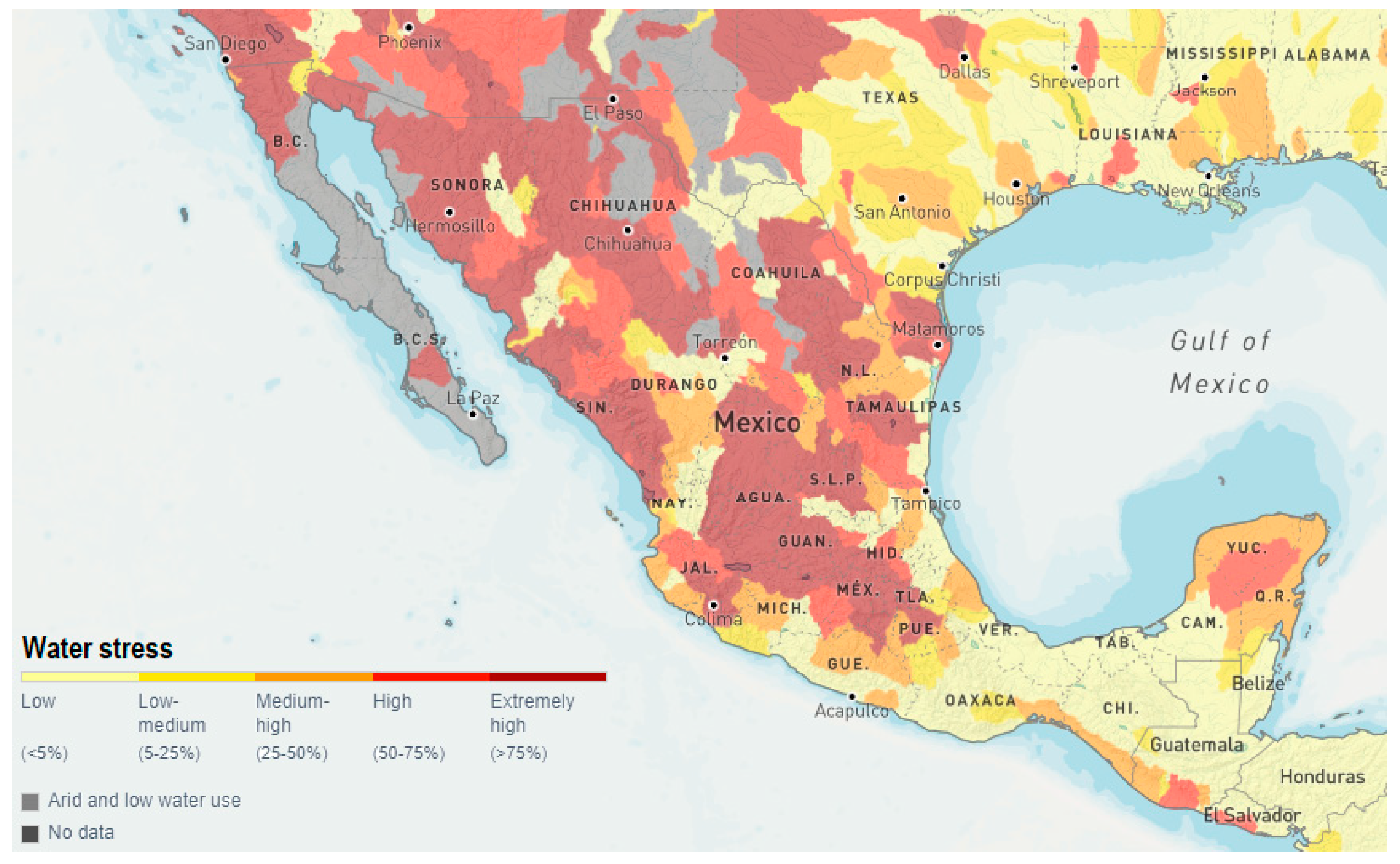
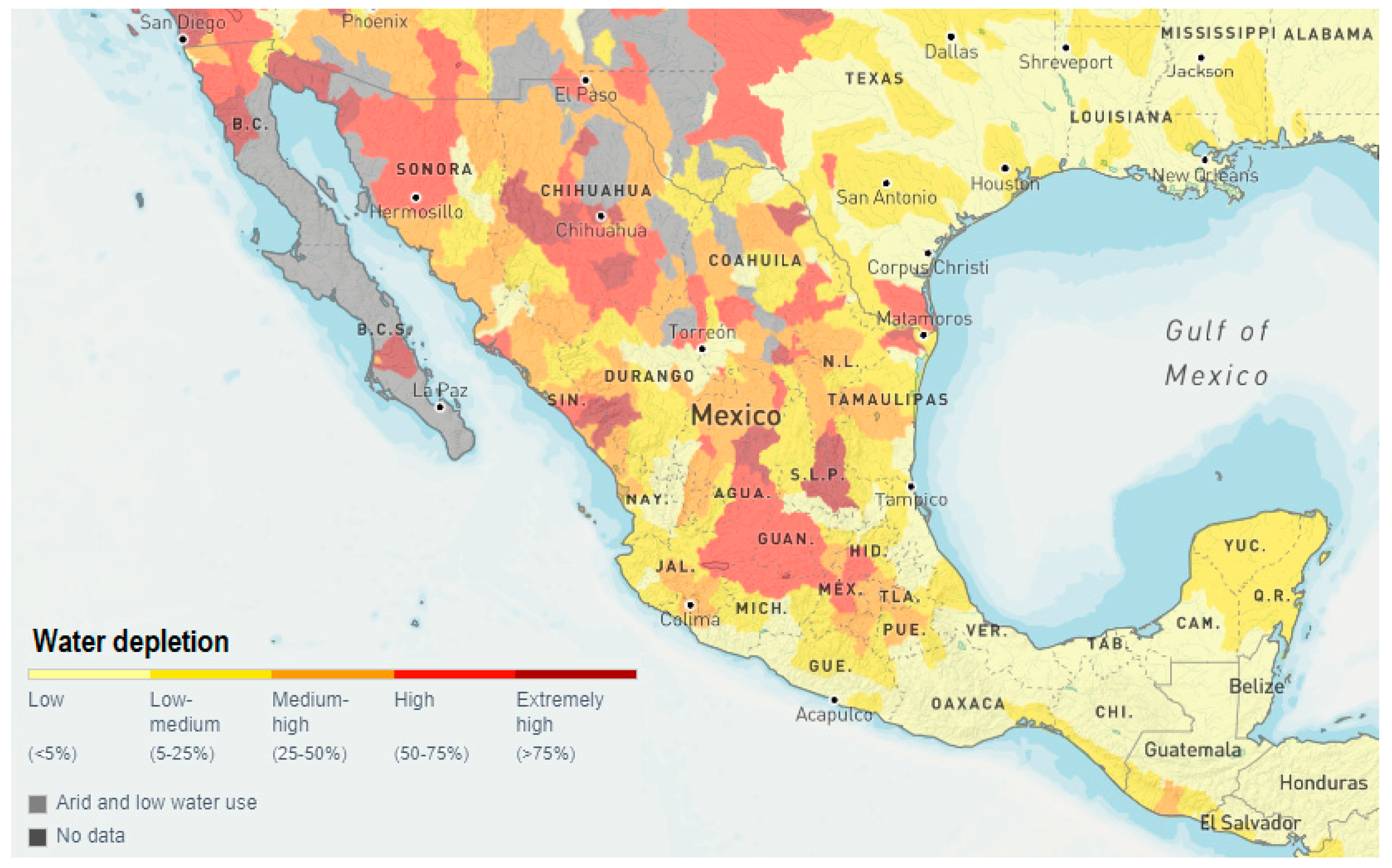

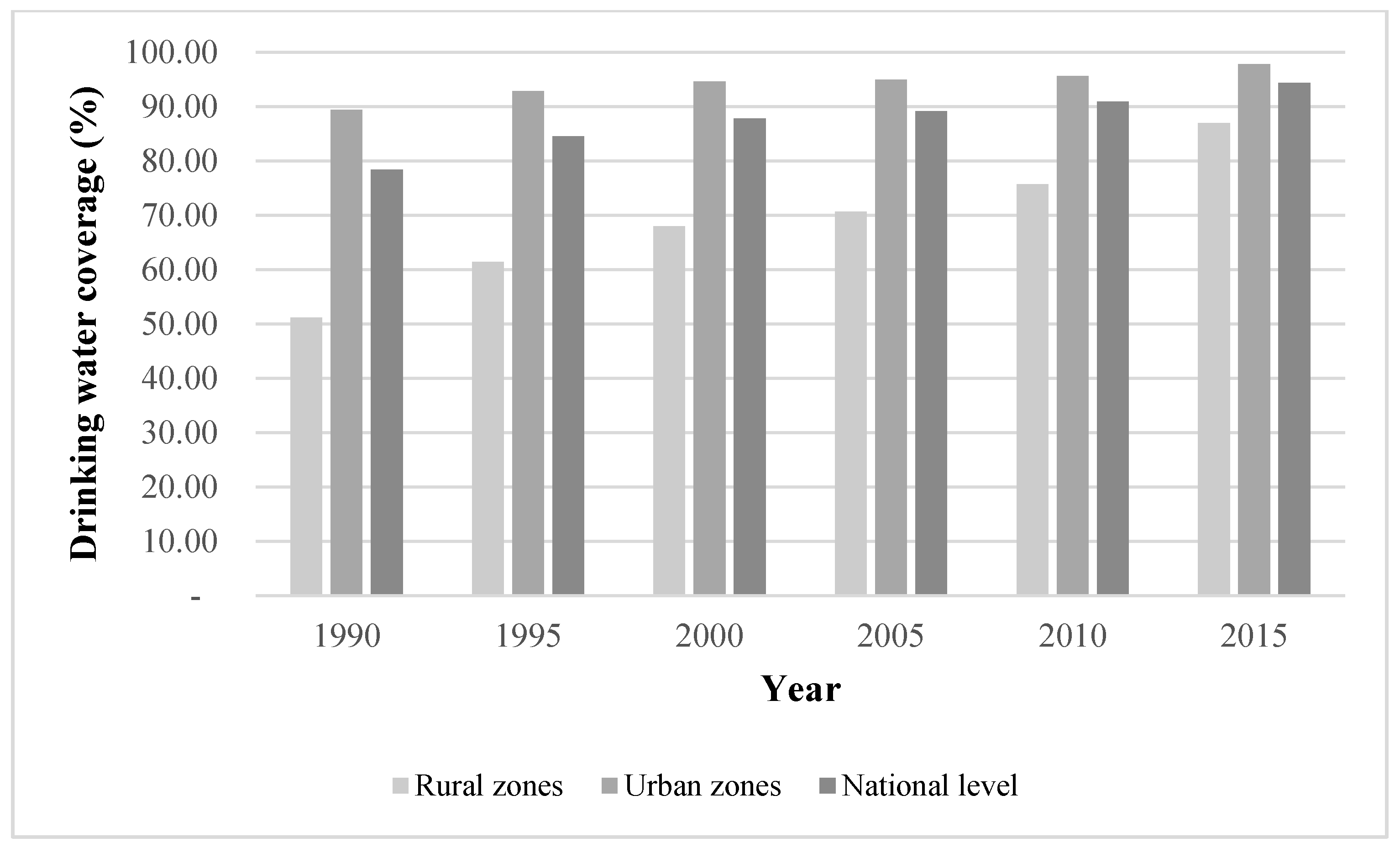
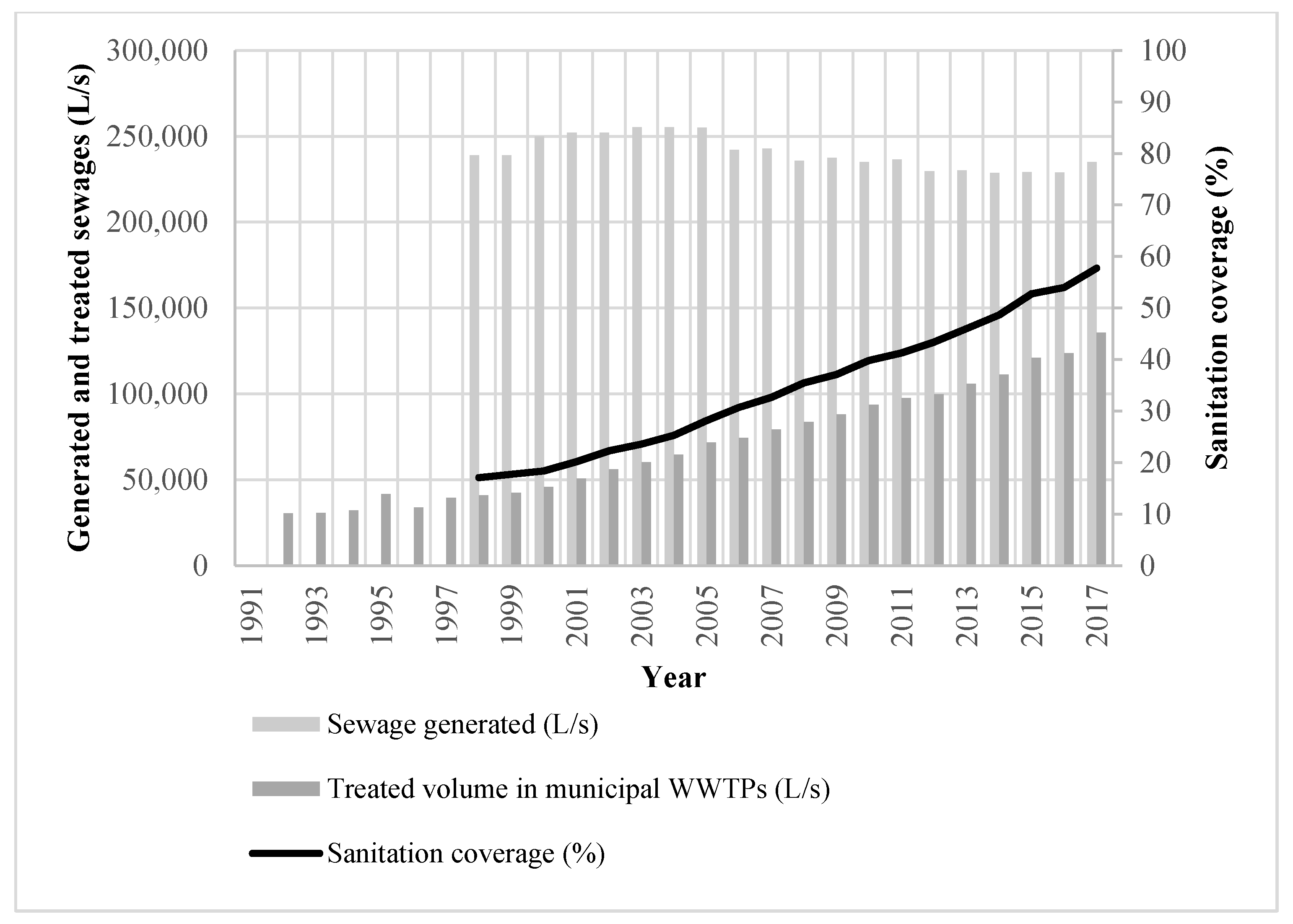
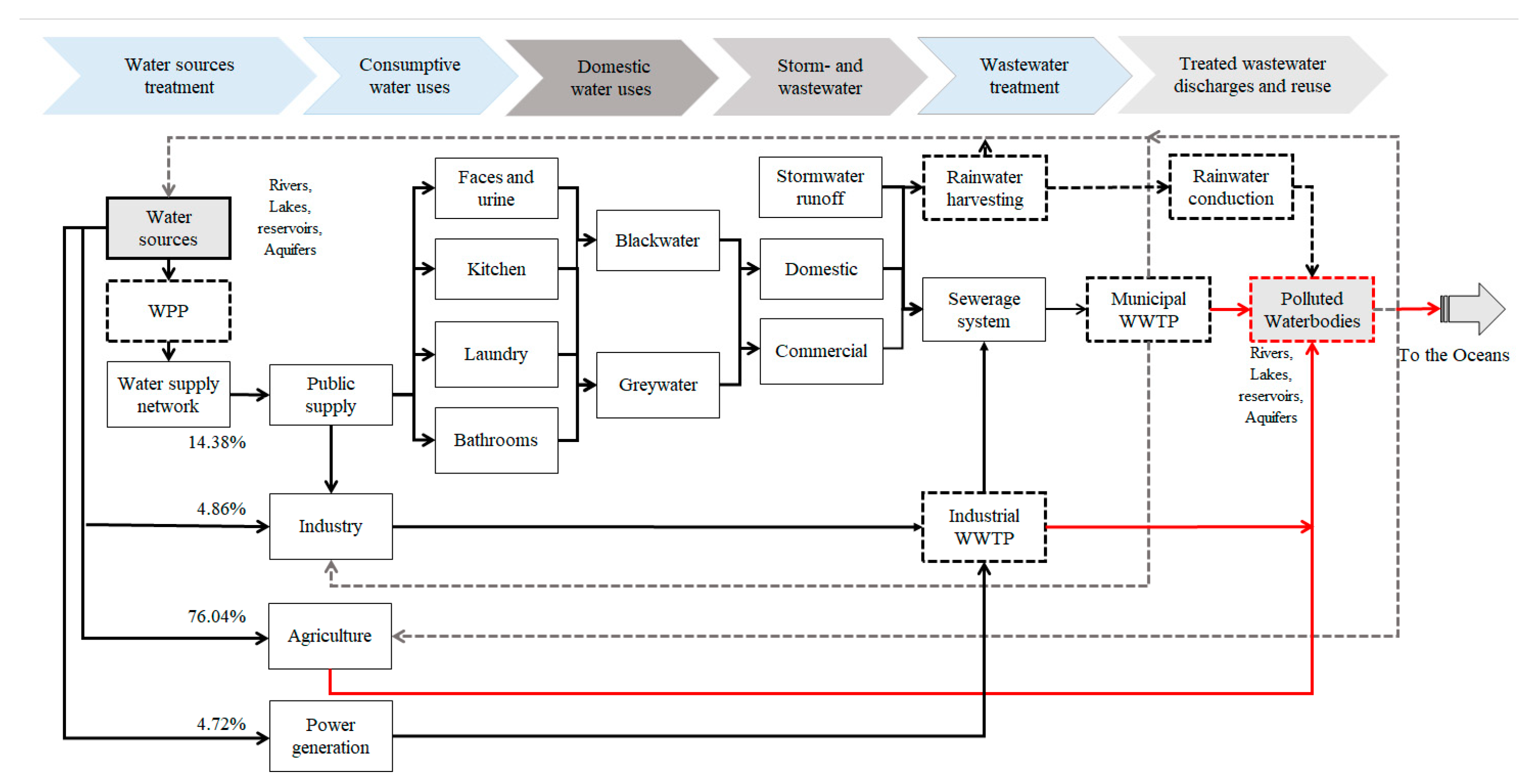
| Year (n) | Total Mid-Year Population (P) | Average Annual Growth Rate (%) |
|---|---|---|
| 1950 | 27,026,573 | |
| 1960 | 36,786,543 | 3.61% |
| 1970 | 50,778,729 | 3.80% |
| 1980 | 67,561,216 | 3.31% |
| 1990 | 84,169,571 | 2.46% |
| 2000 | 98,785,275 | 1.74% |
| 2010 | 113,748,671 | 1.51% |
| 2020 | 127,792,286 | 1.23% |
| 2030 | 138,070,271 | 0.80% |
| 2040 | 144,940,511 | 0.50% |
| 2050 | 148,209,594 | 0.23% |
| Water Use | Origin | Total Volume | Extraction Percentage | |
|---|---|---|---|---|
| Surface Water | Groundwater | |||
| Thousands of hm3 | Thousands of hm3 | Thousands of hm3 | % | |
| Agriculture | 42.47 | 24.32 | 66.80 | 76.04 |
| Public supply | 5.25 | 7.38 | 12.63 | 14.38 |
| Self-supplying industry | 2.04 | 2.23 | 4.27 | 4.86 |
| Electric power (without hydroelectric power) | 3.70 | 0.45 | 4.15 | 4.72 |
| Total | 53.46 | 34.38 | 87.85 | 100.00 |
| Social Dimension | |||
|---|---|---|---|
| Issue | Pros | Cons | Recommended Measures |
| 1. Publicity | Essential to inform the public. Special interest groups may be aware of the plan, but not the public whose ongoing involvement is necessary for success. | Depending on the vehicle (radio, TV, print, etc.), this could be costly in terms of recruiting the public (see 2 below). | Develop a low cost but effective campaign to inform the public about the issues in any wastewater management plan. |
| 2. Public Involvement | Experience throughout the World (e.g., Great Lakes) has shown that public involvement is critical to the success of any sustainability program. | Sustaining public interest and enthusiasm over the long term is difficult. Who pays for travel and other expenses for the public participants? | Establish a Wastewater Management Committee (WMC), with funding, to facilitate public involvement. |
| 3. Degree of Acceptance | Essential for any long-term program. One needs the population to see that the program as necessary for them and for their children, grandchildren, etc. They need to accept the program as benefitting their economy, their health and wellbeing, their spiritual needs, etc. | Provision of costs/benefits may not be easy to translate into concepts that everyone in the population can understand. | The WMC will have the job of analyzing the costs benefits of using wastewater and translating this into language that anyone can understand. |
| 4. Actions of People | Achieving environmental improvement and sustainable communities will depend less on the mandates of government and more on the actions of people, communities, industries, nongovernmental organizations, landowners, and others, working together, often voluntarily. This will lead to a successful design and implementation of a Wastewater Management Plan. | To engage these stakeholders in planning, learning, and acting requires a common sense of community, an effective formal and informal collaborative process, and the sharing of power and authority. Ceding power and authority, when it has long been entrenched, will be difficult. | Experience has shown that when all sectors of society are involved in the development and implementation of a plan, power can be shared. Provide adequate funding for groups (farmers, small scale businesses, etc.) to participate as equals in a WMC. |
| 5. Role of Academia | Essential for the provision of scientific information to make sound decisions. | Academics may not see interacting with the public as part of their research career and may be reluctant to participate. | Once the WMC is established, have its members communicate with senior administrators in the academic community (government and university) to secure participation in the development of the wastewater plan from engineers, scientists, etc. |
| Environmental and Technological Dimension | |||
|---|---|---|---|
| Issue | Pros | Cons | Recommended Measures |
| 6. Combined domestic wastewater with rainwater | Reduction of urban sewage and rainwater infrastructure construction costs. | When domestic wastewater and rainwater are combined, they increase the demands for treatment capacity and, therefore, the costs of investment, maintenance, and operation [36]. | Introduce in municipal construction regulations the separation of domestic wastewater from rainwater. Gradually generate urban infrastructure to separate wastewater from rainwater. |
| 7. In many cases WWTP discharges do not meet environmental regulations | In the absence of complaints and an efficient surveillance system, the government assumes that it is fulfilling its obligations correctly. | Permanent pollution of surface and ground water and harmful effects on the health of people and the ecosystem. | Control the quality of the treated water so that it consistently meets environmental regulations [36]. |
| 8. Current wastewater treatment technologies produce important volumes of biological solids that require special treatment and disposal. | Most of the biological solids from WWTPs are managed and disposed in landfills or reused in agriculture. | When biological solids are not properly disposed, they produce offensive odors to closely settled communities, contaminate surface and groundwater and soils, and generate a large amount of greenhouse effect gases. | Ensure that the biological solids generated are treated appropriately for their use as fertilizer (compost), instead of their disposal in landfills that do not comply with environmental regulations [36]. |
| 9. Current WWT technologies are intensive in the use of energy and have high operation and maintenance costs. | Current technologies are widely used throughout the country. Waste- water treatment plant staff are familiar with these technologies. | Several municipal WWTPs are out of operation throughout the country because of high M&O costs. | It is necessary to introduce sustainable technologies based on natural processes and low M&O costs [39,40]. |
| Economical and Legal Dimension | |||
|---|---|---|---|
| Issue | Pros | Cons | Recommended Measures |
| 10. Most of the technological solutions for municipal WWTP require high energy input and expensive chemical additives which can have a significant impact on the operation costs. | These costs can be offset by the benefits that the community obtains from having clean and safe wastewater discharged into receiving waters. | Municipalities have short administrations (3 years), and they often fail to see the environmental and social benefits of having safe surface and groundwater. | Complying with the condition that the balance of a mass and energy of raw materials, products, and byproducts results in an economic, social, and environmental benefit without compromising the current and future resources of the community [39]. |
| 11. In some cases, municipalities acquire debts to build WWTPs and subsequently cannot afford financial and operating expenses. | It is possible to compensate the financial expenses through the sale of the treated wastewater. | In general, sanitation projects are not planned to recover and reuse the treated wastewater and the value of the investment is thereby lost. | Evaluate the real investment capacity of the community and ensure the necessary resources for its maintenance, operation, and reuse [24]. |
| 12. In Mexico, the costs of energy have increased in recent years due to reduction of domestic oil reserves and lack of investment in renewable energies. | This situation should promote the use of sanitation technologies based on natural processes. | Not enough national technical capacities to promote sanitation technologies based on natural processes with low energy consumption and low M&O costs. | Consider that the energy, maintenance, and operation costs will increase over time, it will be necessary to build technical capacities in sustainable sanitation technologies [24]. |
| 13. Most treated wastewaters are discharged into rivers, lakes, and reservoirs, losing the opportunity to reuse it. | Efficiently treated wastewater protects the quality of surface and groundwater sources of freshwater. | Most of the municipal treated water is not reused in agriculture or industry to lack of incentives. | Rethink the law regarding water use and tax incentives to favor the public, industry, and farmers who reuse reclaimed water in their activities. Implement an education program to make farmers and the public aware of the benefits of reusing water. |
| 14. Sanitation coverage in the country is lower than 60%. It increases few every year. | The programs for the sanitation of wastewater in the country have been maintained in recent years, although not in accordance with the needs of the population. | There is a growing interest from private initiatives to collaborate with government in the cleanup processes of the country’s hydrographic basins. | Introduce government programs such as tax incentives for the private sector to invest in the treatment infrastructure for public potable water and treatment to reduce pollution and promote a culture of care and reuse of treated water at all levels of society. |
| Political Dimension | |||
|---|---|---|---|
| Issue | Pros | Cons | Recommended Measures |
| 15. Most national waterbodies in the country face different contamination levels. | There is increasing awareness of the problem in the government, society, and academia. | The existing governance strategies have not been effective in increasing the sanitation coverage throughout the country. | Adjust the roles of federal, state, and municipal governments to improve the water quality. The states must assume the responsibility of reinforcing the governance schemes to accelerate the participation of society and academia in the decision-making process. |
| 16. Most municipalities pay very low or no taxes for sanitation. | People are happy not to pay higher taxes. | The population does not perceive in the short term the environmental damage and its impacts that are being generated by the lack of sanitation. | To convince the municipalities to charge the users appropriate fees for wastewater treatment services. |
| 17. Investment in sanitation services remains limited. | Public resources could be being applied to other higher-priority programs, such as insecurity and fighting poverty. | Gradual loss of water security in different regions of the country. | Make a significant effort to attract funding to invest in new WWTPs, including tertiary treatment. |
| 18. Lack of transparency in the use of public resources to keep sanitation infrastructure in operation. | This practice has allowed some politicians to use public resources for other programs without being held accountable. | The sanitation infrastructure is gradually being abandoned. | Make the origin and destination of subsidies transparent and accountable. |
| 19. Accountability at the municipal level often remains highly controversial and ineffective. | This has allowed politicians to make use of public resources to improve their political position. | The population’s confidence in the government’s ability to provide basic water supply and sanitation services is gradually being lost. | Create regulatory bodies at the state level and create a national coordinating entity, which has oversight and can regulate the subsector. |
| 20. With the change of municipal government every three years, the employees of the drinking water and sanitation services change. | A new work team enters in which the new municipal government has confidence in its performance. | Capacities created by the previous government are often lost. | Depoliticize the water management organizations so that the permanence of the managerial personnel is not connected to the renewal of municipal administrations. |
Publisher’s Note: MDPI stays neutral with regard to jurisdictional claims in published maps and institutional affiliations. |
© 2021 by the authors. Licensee MDPI, Basel, Switzerland. This article is an open access article distributed under the terms and conditions of the Creative Commons Attribution (CC BY) license (https://creativecommons.org/licenses/by/4.0/).
Share and Cite
de Anda, J.; Shear, H. Sustainable Wastewater Management to Reduce Freshwater Contamination and Water Depletion in Mexico. Water 2021, 13, 2307. https://doi.org/10.3390/w13162307
de Anda J, Shear H. Sustainable Wastewater Management to Reduce Freshwater Contamination and Water Depletion in Mexico. Water. 2021; 13(16):2307. https://doi.org/10.3390/w13162307
Chicago/Turabian Stylede Anda, José, and Harvey Shear. 2021. "Sustainable Wastewater Management to Reduce Freshwater Contamination and Water Depletion in Mexico" Water 13, no. 16: 2307. https://doi.org/10.3390/w13162307
APA Stylede Anda, J., & Shear, H. (2021). Sustainable Wastewater Management to Reduce Freshwater Contamination and Water Depletion in Mexico. Water, 13(16), 2307. https://doi.org/10.3390/w13162307







